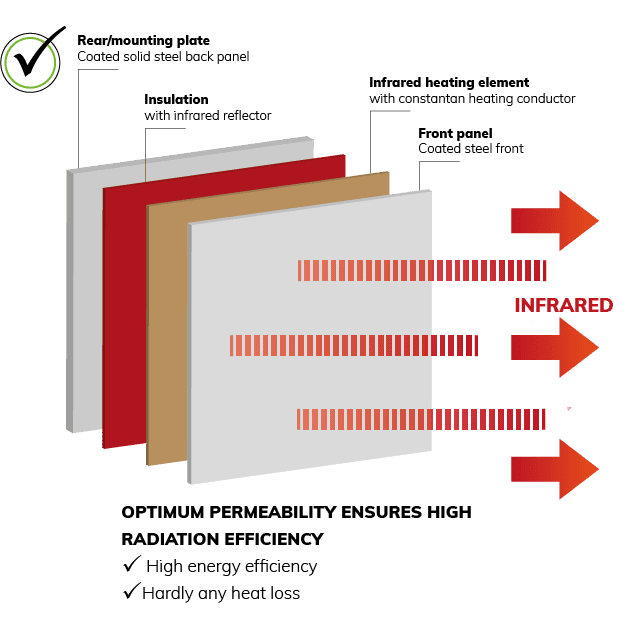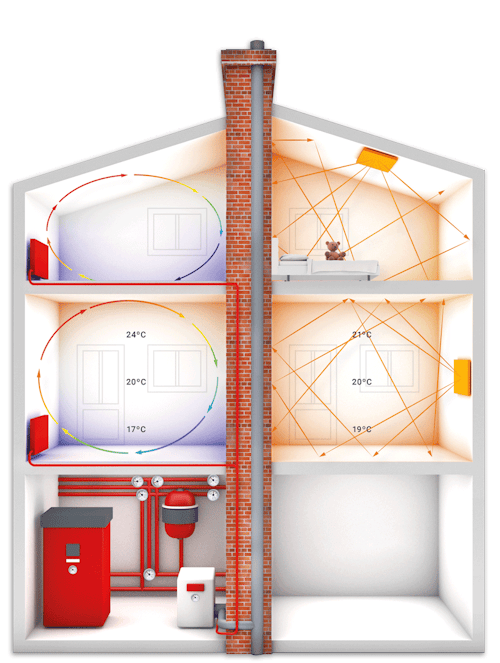Heating with electricity presents numerous advantages over alternative heating systems. Modern electric heating solutions provide exceptional thermal comfort and offer convenient control options. Our heaters are designed for quick and easy installation, requiring minimal maintenance. The initial purchase can be cost-effective, alleviating concerns about future servicing associated with fuel boilers. Furthermore, electric heaters come in various sizes, making them an ideal choice for those looking to save space. With automatic programmable controls, these systems can adjust heating based on temperature fluctuations without any manual intervention. They intelligently detect when heat is required and at what times, ensuring optimal comfort and efficiency. Heating with electricity presents numerous advantages over alternative heating systems. Modern electric heating solutions provide exceptional thermal comfort and offer convenient control options. Our heaters are designed for quick and easy installation, requiring minimal maintenance. The initial purchase can be cost-effective, alleviating concerns about future servicing associated with fuel boilers. Furthermore, electric heaters come in various sizes, making them an ideal choice for those looking to save space. With automatic programmable controls, these systems can adjust heating based on temperature fluctuations without any manual intervention. They intelligently detect when heat is required and at what times, ensuring optimal comfort and efficiency.
The Latin term "infra" means "below", so infrared literally translates to "below red", referring to its position in the electromagnetic spectrum. While humans cannot see low-frequency UV light or high-frequency infrared radiation, we can still feel its effects. For instance, the comforting warmth of a tiled stove or the sun's rays on a chilly winter's day are examples of how we experience infrared warmth in our daily lives. Unlike UV radiation, infrared radiation is safe for us. Our infrared wall heaters and heating panels utilise infrared C, or far infrared radiation, which is completely safe for people. Infrared heating panels operate on a straightforward yet effective principle, consisting of a heating element through which electricity flows, housed within a protective casing. The heating element acts as an electrical resistance, converting 100% of the electrical energy into heat, which is then emitted as infrared radiation. This method offers several advantages over conventional convection heating.
- Basic components:
- A heating element
- A housing
- Insulation* High Quality products only
- Energy conversion:
- Electricity flows through the heating element
- The element acts as an electrical resistance
- 100% of electrical energy is converted to heat
- Heat is emitted as infrared radiation
Advantages over convection heating:
- Direct heating:
- Warms objects and people directly, not just the air
- Reduces air and dust circulation
- Creates more even temperature distribution
- Heat retention:
- Objects and walls store heat
- Room doesn't cool quickly when ventilated
- Mould prevention:
- Effectively dries damp walls
- Reduces mould growth
- Energy efficiency:
- No energy lost heating air
- Quicker to warm a space
- Comfort:
- Provides a more natural feeling of warmth
- Reduces cold spots in rooms

Infrared heating operates differently from conventional radiators, offering several advantages: Whilst traditional radiators primarily heat the air, infrared heaters warm surfaces and objects directly. This method has several benefits:
- Efficient heat storage: Walls and objects retain heat three times longer than air, gradually releasing warmth back into the living space.
- Reduced moisture issues: By heating surfaces directly, infrared heaters prevent condensation and moisture build-up on walls.
- Improved air quality: Unlike conventional heaters that circulate air, infrared heating doesn't stir up dust or bacteria, leading to a cleaner indoor environment.
- Minimised draughts: As infrared heating doesn't rely on air circulation, it reduces the occurrence of uncomfortable draughts.
This approach to heating not only enhances comfort but also contributes to a healthier living space.
Conventional convection heating, such as underfloor heating or radiators, warms the air. In contrast, an infrared heater warms objects directly. Heated objects, such as walls or floors, then radiate this heat themselves, creating a more comfortable indoor climate. If you quickly air out the room, and it cools down, this won’t happen with infrared heating.
Indeed, if the infrared heater radiates onto an exterior wall that is affected by mould, the heat will dry that wall. The dew point shifts further outwards. A dry wall is less susceptible to mould growth.
Despite electricity's reputation for being expensive, infrared heating panels offer an efficient and affordable heating solution. The benefits of investing in infrared heating are multifaceted:
- Lower initial costs: Up to 70% less than conventional systems
- No maintenance or additional expenses
- 100% ecological when paired with solar or wind power
With impending bans on oil and gas heating systems across Europe, switching to infrared heating is a forward-thinking choice.
A key advantage of infrared heating over water-based systems is its direct energy conversion at the point of use, eliminating line losses. Water-based systems can lose up to 30% of energy through poorly insulated pipework. In summary, infrared heating offers a cost-effective, environmentally friendly alternative that aligns with future energy regulations.
Indeed. If you heat a house or flat with infrared, you have significantly lower acquisition costs compared to those associated with geothermal energy, gas, pellets or a heat pump. With good insulation, power consumption is also kept within reasonable limits. Each room must be considered individually. It makes a considerable difference whether the bathroom, the living room, the bedroom or a conservatory is to be heated with infrared.
The selection and placement of heating panels depend on several factors related to the space you wish to heat:
- Room dimensions: The size of the area directly influences the number and power of panels required.
- Building characteristics: Insulation quality, presence of Large windows, ceiling height, construction materials. A basic room height of 2.60 m is
used for the calculation: no insulation - 150-250 Watt/m²
bad insulation - 100-150 Watt/m²
medium insulation - 0-100 Watt/m²
good insulation - 10-50 Watt/m²
passive house - 0-10 Watt/m²
- Desired temperature: The target room temperature affects the heating capacity needed.
- Room usage: Different activities may require varied heating solutions.
- Existing heat sources: Consider any supplementary heating already in place.
- Architectural features: Placement may be influenced by room layout and available wall/ceiling space.
To determine the most efficient heating solution, it's advisable to conduct a thorough assessment of these factors. This will ensure optimal panel selection and positioning for effective and energy-efficient heating.
7. Wattage Calculator: See formula below, or use our Wattage Calculator page by clicking here.

Infrared panels offer flexible installation options:
- Ceiling mounting
- Wall mounting
- Freestanding placement using a stand
However, for optimal performance, consider these guidelines:
- Avoid installing opposite reflective surfaces (e.g., windows, glass, glazed tiles) to prevent heat loss through reflection.
- Ensure panels are not obstructed by curtains or furniture to maintain effective heat distribution.
- In older buildings or rooms with damp outer walls, install on inner walls to directly warm and dry outer walls.
- If ceiling-mounted, avoid positioning directly above seating areas, as some may find overhead radiation uncomfortable.
- Consider room layout and usage patterns when deciding on placement.
- Ensure proper clearance around panels for safety and efficiency.
By following these guidelines, you can maximise the effectiveness of your infrared heating system whilst maintaining comfort and energy efficiency.
The thermostat's placement is crucial for efficient infrared heating:
- Accurate temperature measurement: The thermostat should be positioned where it can accurately gauge the room's temperature.
- Avoid heat sources: Don't place the thermostat near heaters or other heat-emitting devices, as this can lead to false readings.
- Steer clear of cool spots: Window sills and other naturally cool areas can skew temperature measurements.
Unsuitable locations for thermostats include:
- Areas with constant direct sunlight
- Behind curtains
- Inside or behind furniture
Proper thermostat placement ensures:
- Accurate temperature control
- Optimal energy efficiency
- Consistent comfort throughout the room
For best results, position the thermostat on an interior wall, away from heat sources and draughts, at a height of about 1.5 metres. This allows for the most representative temperature reading of the occupied space.
It is evident that additional energy is required. If your property is older and/or the exterior wall is damp, it is advisable to install the infrared heater on the interior wall. This increases the surface temperature of the exterior wall due to irradiation. The drying process improves the thermal insulation because the dew point is situated further towards the outside.
Yes, we supply the heaters with 2 remote controls, one is the thermostat for the heater and the other a controller for the LED light.
The infrared heating panel and the LED light frame are supplied ready to plug in. Installation does not require any electrical work. We do recommend an electrician for installations on wall and ceiling.
The heat from our infrared panels has an optimal radiation range of up to four metres. Within this distance, the infrared radiation should reach the areas to be heated, such as walls, floors, and ceilings.
Heating with electricity is straightforward, quick, and environmentally friendly. Simply plug in the heater, and you’re ready to enjoy a comfortable space. Experience a healthier indoor climate, as electric heaters operate without the need for fuel or gas, eliminating the hassle of dirt, ash, dust, and unpleasant odours. Moreover, heating with electricity is not only clean but can also be a sustainable choice for those looking to reduce their environmental impact.





